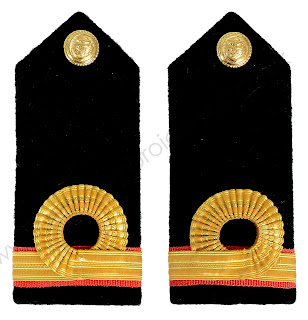Are The Shoulder Ties On An Officers Epauletts To Drag Them Out Of Risk?
There is a thought that epaulets were grown carefully as a
fancy piece that signified rank and evoked the picture of the pauldron
(shoulder protective layer).
Extravagant high-position ones, for example, what King Oscar
wears in this image surely resemble that.
In actuality, epaulets created as an increasingly
commonsense gadget.
Every one of them have a couple of lashes over their body.
These hold up hardware, similar to the ammo pack, or an explosive pocket.
The epaulet was initially intended to shield the lash from
slipping and the trooper getting tangled in it. Numerous garbs had just one,
for the shoulder where the lash went.
At that point, between taking note of that the shoulder is
an effectively obvious area for rank, and the custom of designing defensive
layer with strips, extravagant official epaulet was conceived. It was in
reality a greater amount of block than an assistance in conveying hardware,
thus lower-positioning officials regularly just got one.
Military hardware step by step improved, and garbs turned
out to be more about common sense than garish appearance, and epaulets
decreased and milder, staying as spots to convey badge. They have practically
vanished from field garbs, since present day body protection conceals them, in
any case.
One thing that epaulets have never been is drag handles.
They are simply not sufficient for that, generally being joined toward one side
with only a catch.
They were an insincerity of regalia. Catches of sleeves of
coats were it is stated, to keep the troopers of Fredrick the Great from
cleaning their runny noses on the sleeves of their beautiful outfits. They were
likely a branch, and advancement of the enormous epauletts of the Napoleon time
that were an artificiality to make the shoulders of the troopers more extensive
and all the more forcing. The equivalent can be said for the Bear skin royal navy cap
and shakos that additional a foot or more to the normal troopers tallness.
and shakos that additional a foot or more to the normal troopers tallness.
Review how a pooch when irate raises its hackles...the hair
on its shoulders and along its back? All to make himself look greater than he
truly is to another male, or for this situation, trooper. Envision in the
Napoleonic days, when men were somewhat littler in stature, perhaps 5' 7"
or thereabouts. Include a 12" cap to them and wide carried coat and you
had a noteworthy sight. So they made it a stride more remote. They put all the
six footers in a single development and called them Grenadiers, since they
needed to toss substantial iron explosives. Presently include a 12" bear
skin royal navy cap to them, and wide epauletted coats and you had a development of what
resembled 7" foot mammoths coming to kick ass. Prussian King Wilhelm of
Prussia had a regiment of exceptionally tall for the time, more than 6 foot,
and ventured to such an extreme as to pay bounties and endorsed abducting of
tall young men and men to round out the positions of his prize regiment. It was
more a leisure activity, and no record exists of it consistently observing
battle. They were known as the Potsdam Giants. They must be in any event 6'
2" in tallness.
You can see the waiting impacts in men's tailored suits. I
mean extremely, not we all need two crawls of cushioning in the shoulders of a
suit to make us appear as though we have deltoids. A great deal of it is
unadulterated vanity.
Obviously, epauletts doe fill a need, you can fold your
beret into it as certain nationalities do. Some attach their identification or
rank to them.
They are strongly not made to lift anything with except if
you are light enough to swing from around 6 strands of texture string, which is
the thing that the regular catch is fastened with.
At the point when Australia sent a peacekeeping power to
East Timor the uniform fused a gigantic fabric brassard that dangled from the
epaulet on the left shoulder to show the position and the unit fix since all
other accessible space was secured by body defensive layer.
Additionally I think there was a "salvage drag handle"
on the back of the a couple of the variations of strategic vest approved for
wear in those days. The handle was arranged close to the neck. I don't have a
clue if the handle was really sufficiently able to safeguard anybody.
As others have effectively noted, warrior regalia are not
intended for that reason.
Notwithstanding, this is a superbly sensible inquiry - the
shoulders of suits utilized by most race vehicle drivers are undoubtedly
expected for that reason. This is required by the FIA, whose principles are
utilized for motorsports occasions the world over.
Archive 8856-2000 depicts the prerequisites for driver
garments, and segment 5.1 says, "Ties proposed for lifting the wearer will
be joined into the article of clothing over each shoulder."
Since antiquated occasions people have worn
elaborate,dazzlingly hued costumes,plumed quills for headgear ,face paint and
so forth for scaring their adversaries in fight.
The epaulet additionally fills a comparable need ,giving the
fantasy of an augmented shoulder and causing you to accept that you are going
toward a physically more grounded adversary.
In current occasions it additionally fills in as an
identification of one's position notwithstanding terrorizing.



Comments
Post a Comment